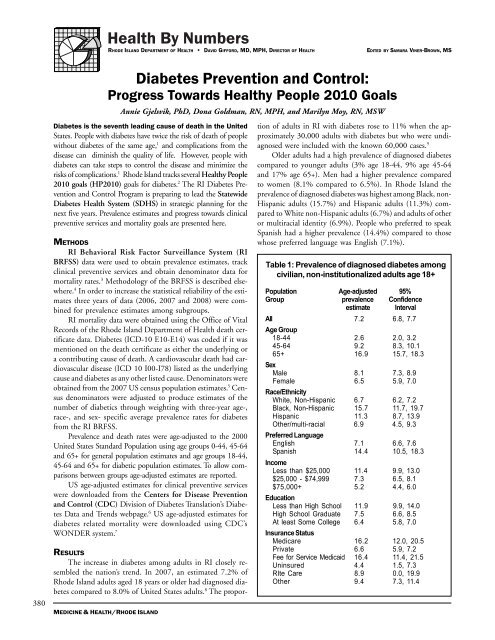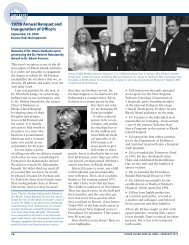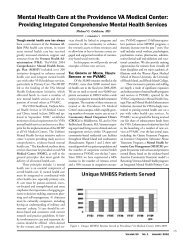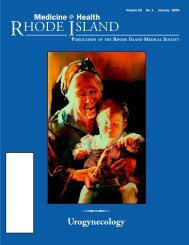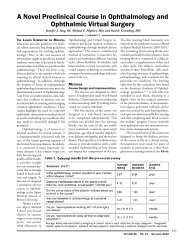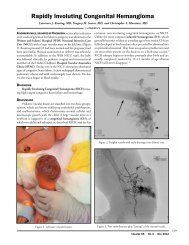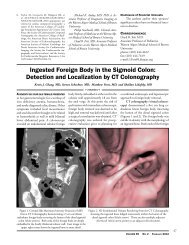Hyperuricemia & Gout - Rhode Island Medical Society
Hyperuricemia & Gout - Rhode Island Medical Society
Hyperuricemia & Gout - Rhode Island Medical Society
You also want an ePaper? Increase the reach of your titles
YUMPU automatically turns print PDFs into web optimized ePapers that Google loves.
RHODE ISLAND DEPARTMENT OF HEALTH • DAVID GIFFORD, MD, MPH, DIRECTOR OF HEALTH<br />
EDITED BY SAMARA VINER-BROWN, MS<br />
380<br />
MEDICINE & HEALTH/RHODE ISLAND<br />
Diabetes Prevention and Control:<br />
Progress Towards Healthy People 2010 Goals<br />
Annie Gjelsvik, PhD, Dona Goldman, RN, MPH, and Marilyn Moy, RN, MSW<br />
Diabetes is the seventh leading cause of death in the United<br />
States. People with diabetes have twice the risk of death of people<br />
without diabetes of the same age, 1 and complications from the<br />
disease can diminish the quality of life. However, people with<br />
diabetes can take steps to control the disease and minimize the<br />
risks of complications. 1 <strong>Rhode</strong> <strong>Island</strong> tracks several Healthy People<br />
2010 goals (HP2010) goals for diabetes. 2 The RI Diabetes Prevention<br />
and Control Program is preparing to lead the Statewide<br />
Diabetes Health System (SDHS) in strategic planning for the<br />
next five years. Prevalence estimates and progress towards clinical<br />
preventive services and mortality goals are presented here.<br />
METHODS<br />
RI Behavioral Risk Factor Surveillance System (RI<br />
BRFSS) data were used to obtain prevalence estimates, track<br />
clinical preventive services and obtain denominator data for<br />
mortality rates. 3 Methodology of the BRFSS is described elsewhere.<br />
4 In order to increase the statistical reliability of the estimates<br />
three years of data (2006, 2007 and 2008) were combined<br />
for prevalence estimates among subgroups.<br />
RI mortality data were obtained using the Office of Vital<br />
Records of the <strong>Rhode</strong> <strong>Island</strong> Department of Health death certificate<br />
data. Diabetes (ICD-10 E10-E14) was coded if it was<br />
mentioned on the death certificate as either the underlying or<br />
a contributing cause of death. A cardiovascular death had cardiovascular<br />
disease (ICD 10 I00-I78) listed as the underlying<br />
cause and diabetes as any other listed cause. Denominators were<br />
obtained from the 2007 US census population estimates. 5 Census<br />
denominators were adjusted to produce estimates of the<br />
number of diabetics through weighting with three-year age-,<br />
race-, and sex- specific average prevalence rates for diabetes<br />
from the RI BRFSS.<br />
Prevalence and death rates were age-adjusted to the 2000<br />
United States Standard Population using age groups 0-44, 45-64<br />
and 65+ for general population estimates and age groups 18-44,<br />
45-64 and 65+ for diabetic population estimates. To allow comparisons<br />
between groups age-adjusted estimates are reported.<br />
US age-adjusted estimates for clinical preventive services<br />
were downloaded from the Centers for Disease Prevention<br />
and Control (CDC) Division of Diabetes Translation’s Diabetes<br />
Data and Trends webpage. 6 US age-adjusted estimates for<br />
diabetes related mortality were downloaded using CDC’s<br />
WONDER system. 7<br />
RESULTS<br />
The increase in diabetes among adults in RI closely resembled<br />
the nation’s trend. In 2007, an estimated 7.2% of<br />
<strong>Rhode</strong> <strong>Island</strong> adults aged 18 years or older had diagnosed diabetes<br />
compared to 8.0% of United States adults. 8 The proportion<br />
of adults in RI with diabetes rose to 11% when the approximately<br />
30,000 adults with diabetes but who were undiagnosed<br />
were included with the known 60,000 cases. 9<br />
Older adults had a high prevalence of diagnosed diabetes<br />
compared to younger adults (3% age 18-44, 9% age 45-64<br />
and 17% age 65+). Men had a higher prevalence compared<br />
to women (8.1% compared to 6.5%). In <strong>Rhode</strong> <strong>Island</strong> the<br />
prevalence of diagnosed diabetes was highest among Black, non-<br />
Hispanic adults (15.7%) and Hispanic adults (11.3%) compared<br />
to White non-Hispanic adults (6.7%) and adults of other<br />
or multiracial identity (6.9%). People who preferred to speak<br />
Spanish had a higher prevalence (14.4%) compared to those<br />
whose preferred language was English (7.1%).<br />
Table 1: Prevalence of diagnosed diabetes among<br />
civilian, non-institutionalized adults age 18+<br />
Population Age-adjusted 95%<br />
Group prevalence Confidence<br />
estimate Interval<br />
All 7.2 6.8, 7.7<br />
Age Group<br />
18-44 2.6 2.0, 3.2<br />
45-64 9.2 8.3, 10.1<br />
65+ 16.9 15.7, 18.3<br />
Sex<br />
Male 8.1 7.3, 8.9<br />
Female 6.5 5.9, 7.0<br />
Race/Ethnicity<br />
White, Non-Hispanic 6.7 6.2, 7.2<br />
Black, Non-Hispanic 15.7 11.7, 19.7<br />
Hispanic 11.3 8.7, 13.9<br />
Other/multi-racial 6.9 4.5, 9.3<br />
Preferred Language<br />
English 7.1 6.6, 7.6<br />
Spanish 14.4 10.5, 18.3<br />
Income<br />
Less than $25,000 11.4 9.9, 13.0<br />
$25,000 - $74,999 7.3 6.5, 8.1<br />
$75,000+ 5.2 4.4, 6.0<br />
Education<br />
Less than High School 11.9 9.9, 14.0<br />
High School Graduate 7.5 6.6, 8.5<br />
At least Some College 6.4 5.8, 7.0<br />
Insurance Status<br />
Medicare 16.2 12.0, 20.5<br />
Private 6.6 5.9, 7.2<br />
Fee for Service Medicaid 16.4 11.4, 21.5<br />
Uninsured 4.4 1.5, 7.3<br />
RIte Care 8.9 0.0, 19.9<br />
Other 9.4 7.3, 11.4


